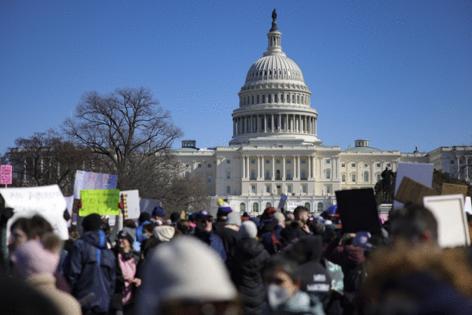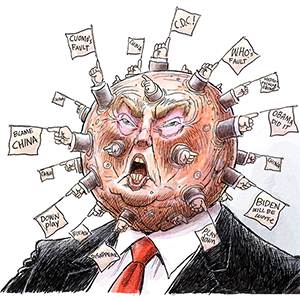Agency firings prompt worries about preparedness, FDA inspectors
Published in News & Features
WASHINGTON — Ongoing firings at the Department of Health and Human Services and its subagencies will likely impact a sweeping number of agency functions ranging from pandemic preparedness to food and drug inspections, experts say.
Just days after Robert F. Kennedy Jr. was sworn in as secretary of Health and Human Services, the department began firing a host of employees. The layoffs, which occurred throughout the agencies, started on Friday, and some estimates put the number in the thousands.
HHS confirmed on Friday that cuts were occurring but declined to provide details on which positions would be affected or how it was determined which positions would be cut.
“HHS is following the Administration’s guidance and taking action to support the President’s broader efforts to restructure and streamline the federal government,” a spokesperson wrote in a statement. “This is to ensure that HHS better serves the American people at the highest and most efficient standard.”
In an interview with Laura Ingraham on Thursday, Kennedy said that he would be “surprised” if staffing cuts at HHS reached 50%, noting that a cut of that magnitude would account for about 90,000 employees.
“The lower-level employees at HHS, most of them are public-spirited, good public servants, good American patriots and hard-working people,” he told Ingraham.
“What I’m interested in are moving around, moving away, the people who have made really bad decisions. For example, on the nutrition guidelines … there’s people at [the National Institutes of Health] that are involved in the amyloid plaque scandals that derailed Alzheimer’s treatment for 20 years. It’s all corruption,” he said.
The Centers for Disease Control and Prevention, NIH, Food and Drug Administration and Centers for Medicare & Medicaid Services did not return requests for comment.
View from the Hill
In Congress, Democrats are pushing back against the staffing cuts.
House Appropriations ranking member Rosa DeLauro, D-Conn., lambasted the cuts to the NIH in a statement over the weekend, raising concerns that the cuts to staff will hinder key research on Alzheimer’s disease.
“NIH is the crown jewel of biomedical research,” DeLauro said. “If President Trump and Elon Musk destroy it, we will never know about the cures and life-saving treatments that are left behind. It will be the American people who suffer.”
In a letter sent to Kennedy that was posted on Bluesky on Friday, Rep. Greg Stanton, D-Ariz., condemned HHS’ reported cuts specifically to the Indian Health Service, raising concerns that it could affect health care providers like nurses, doctors and dentists in rural and underserved areas.
“The federal government has a duty to meaningfully address these health disparities, and even with the current staffing levels, many of these essential services are not met,” he said.
Sen. Jon Ossoff, D-Ga., also denounced the cuts to the CDC, which is headquartered in Georgia, saying in a tweet Friday that it leaves the country vulnerable to disease.
“President Trump’s indefensible, indiscriminate firing of more than 1,000 CDC personnel in a single day leaves Americans exposed to disease and devastates careers and livelihoods for the world’s most talented doctors and scientists, many of them here in Georgia,” Ossoff wrote.
Some Republicans, including Sens. Katie Britt of Alabama and Susan Collins of Maine, have called into question Trump administration actions to cut how much the NIH will cover in indirect research costs. Few, if any, have addressed the staffing cuts yet.
Potential effects at FDA
Howard Sklamberg, a partner at Arnold & Porter and a former FDA official, said in an interview that cuts could have severe impacts to a wide range of FDA functions, but they could leave the agency’s inspector workforce particularly vulnerable.
He said the FDA has historically had trouble attracting enough foreign inspectors, a job that requires extensive travel, as evidenced by a Government Accountability Office report recommending that the agency boost staffing. He emphasized that it takes years for inspectors to develop their skill set and they’re not easy to replace if the agency later needs to refill cut positions.
He also said staffing cuts could even affect FDA functions like publishing guidance documents, which provide industry with instruction when it develops products for the FDA to review.
Sklamberg said that half of the agency’s approximately $7 billion annual budget comes from user fees, which the agency collects from applicants who submit their products to the agency to be reviewed. He said it would be “strange” if HHS made cuts to the portions of the agency funded by user fees, given that it actually wouldn’t save taxpayer dollars.
He said the impacts of mass firings likely won’t be immediate but will be felt in the long run.
“If you cut the number of police on the beat in a city, does that mean the crime rate’s going to go up? Well, not the next day, but the idea is it will eventually,” he said.
Pandemic preparedness
Richard Besser, former acting director of the CDC and the president and CEO of the Robert Wood Johnson Foundation, said in an email that the scope of the current CDC workforce cuts are “unprecedented.”
He is particularly concerned about how cuts will affect the CDC’s Epidemic Intelligence Service, which monitors disease outbreaks that could turn into pandemics. While those jobs have been spared, Besser said he’s concerned about potential future cuts.
“While the impact on the public will take time to be felt, the impact on these public servants is happening now,” he said. “Every major health agency has already been affected, including CDC, FDA, and NIH.”
Lawrence Gostin, a law professor at Georgetown University and director of the World Health Organization Collaborating Center for National and Global Health Law, said that even before staffing cuts, the CDC had been hindered by being ordered to halt working with the World Health Organization.
He said the agency will be “hobbled” in its ability to respond and curb outbreaks before they come epidemics and pandemics, pointing to the ongoing outbreak of H5N1 throughout the country.
“In only a few weeks in office, the United States is now less prepared for a pandemic than I can ever think of in my decades working with U.S. health agencies,” Gostin said.
A group of eight Biden-era health agency leaders, including former NIH Director Monica Bertagnolli and former CDC Director Mandy Cohen, released a joint statement over the weekend condemning the decision to fire hoards of employees.
“These individuals are not numbers on a spreadsheet,” they wrote. “They are dedicated and passionate public servants who have committed their careers to working on behalf of the American people. We owe them a debt of gratitude, not a pink slip.”
Mary Woolley, the CEO of Research!America, a nonprofit research advocacy group, said in a statement Friday that the group is “deeply concerned” that cutting staffing numbers will hinder medical progress.
“We urge the administration to reconsider these actions and refrain from further sweeping leadership and staff cuts,” she said. “Our nation cannot afford to hollow out our research and public health assets. Patients are waiting; lives are at stake.”
©2025 CQ-Roll Call, Inc., All Rights Reserved. Visit cqrollcall.com. Distributed by Tribune Content Agency, LLC.







Comments